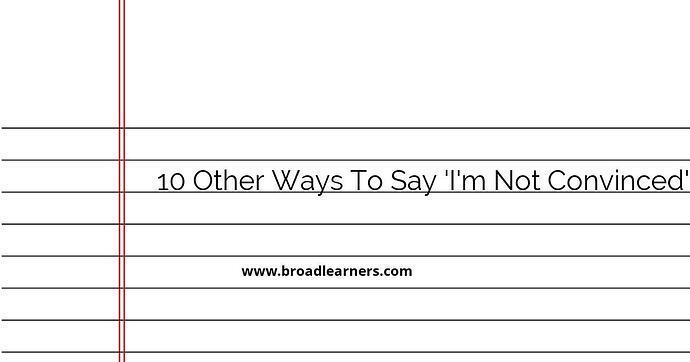When expressing doubt or skepticism, there are various ways to say 'I'm not convinced' that can make your statement more impactful and persuasive. Here are 10 alternative phrases you can use:
- I remain unconvinced
- I'm skeptical
- I have reservations
- I'm not persuaded
- I'm not swayed
- I'm not sold
- I have my doubts
- I'm not entirely convinced
- I'm still on the fence
- I'm not buying it
Let's explore each alternative phrase in more detail:
1. I remain unconvinced
This phrase conveys a strong sense of skepticism and indicates that you have not been convinced by the argument or evidence presented. It emphasizes your firm stance on the matter.
Example:
I have carefully considered your proposal, but I remain unconvinced of its feasibility.
2. I'm skeptical
By saying 'I'm skeptical,' you express doubt or uncertainty about the validity or truthfulness of the information or argument. It suggests that you need more evidence or convincing arguments to be persuaded.
Example:
I'm skeptical about the claims made in the advertisement. Can you provide more evidence to support them?
3. I have reservations
'I have reservations' implies that while you may not completely dismiss the idea or argument, you still have concerns or doubts that prevent you from fully accepting or endorsing it.
Example:
I appreciate your proposal, but I have reservations about its potential impact on our budget.
4. I'm not persuaded
Saying 'I'm not persuaded' indicates that the presented arguments or evidence have not been convincing enough to change your opinion or belief. It suggests that you require stronger or more compelling reasons to be convinced.
Example:
Despite your explanation, I'm not persuaded that this is the best course of action.
5. I'm not swayed
'I'm not swayed' expresses that you have not been influenced or moved by the argument or evidence provided. It implies that you need stronger or more compelling reasons to change your viewpoint.
Example:
The speaker's arguments did not sway me. I still hold my original opinion.
6. I'm not sold
By saying 'I'm not sold,' you convey that you are not convinced or persuaded by the proposal, idea, or argument. It suggests that you need more convincing or compelling evidence to accept it.
Example:
I appreciate your enthusiasm, but I'm not sold on the benefits of this new product.
7. I have my doubts
'I have my doubts' indicates that you harbor reservations or uncertainties about the validity or effectiveness of the subject matter. It implies that you are skeptical and need more convincing evidence to dispel your doubts.
Example:
I have my doubts about the accuracy of the survey results. Can you provide more information on the methodology?
8. I'm not entirely convinced
Saying 'I'm not entirely convinced' acknowledges that there may be some merit to the argument or idea, but you still have reservations or doubts that prevent you from fully accepting it.
Example:
I see some potential in your proposal, but I'm not entirely convinced it will achieve the desired outcomes.
9. I'm still on the fence
'I'm still on the fence' suggests that you have not yet made a definitive decision or formed a strong opinion about the matter. It indicates that you are open to further discussion or persuasion.
Example:
I'm still on the fence regarding this issue. I need more information before I can take a stance.
10. I'm not buying it
By saying 'I'm not buying it,' you express disbelief or skepticism towards the argument or proposition. It conveys that you find the argument unconvincing or lacking credibility.
Example:
I'm sorry, but I'm not buying your explanation for the sudden change in plans.
Using these alternative phrases will help you convey your skepticism or doubts with clarity and sophistication. Choose the phrase that best suits the context and your level of skepticism, and remember to back up your statement with logical reasoning or evidence.
Did I miss anything? Respond below
